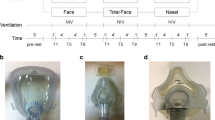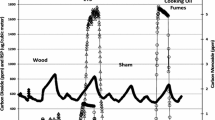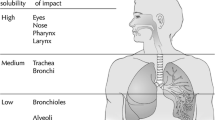Abstract
Exposure to n-butanol vapour gave rise to a sensory irritation response which was measured by the reflexively induced decrease in respiratory rate in mice according to the American standard method (E981-84). The response reached maximum within the 1st min of exposure. In this period the expected threshold response (RD-0) and the concentration expected to depress the respiratory rate by 50% (RD-50) were extrapolated to be 233 ppm and 11696 ppm, respectively. The response followed the dynamics of a bimolecular reaction between butanol and the sensory irritant receptor. For concentrations below 3000 ppm, the response faded due to desensitization. However, concentrations above 3000 ppm gave rise to a new decrease in respiratory rate due to activation of lung receptors. Two types of lung receptors, probably J-receptors and stretch receptors, were involved. The sensory irritation response measured by the standard method gave a threshold response which was comparable to that found by electrophysiological experiments in rats. The irritation response in man as well as the maximum allowable concentration in the working environment were adequately predicted from the sensory irritation response in mice.
Similar content being viewed by others
References
Alarie Y (1973) Sensory irritation by airborne chemicals. CRC Crit Rev Toxicol 2: 299–363
Alarie Y (1981a) Dose-response analysis in animal studies: prediction of human responses. Environ Health Perspect 42: 9–13
Alarie Y (1981b) Toxicological evaluation of airborne chemical irritants and allergens using respiratory reflex reactions. In: Leong KJ (ed) Proceedings of the inhalation toxicology and technology symposium. Ann Arbor Science, Collingwood, pp 207–231
ASTM (1984) Standard test method for estimating sensory irritancy of airborne chemicals. Designation: E 981-84. American Society for Testing and Materials, Philadelphia, pp 1–16
Auty RM, Branch RA (1976) The elimination of ethyl, n-propyl, n-butyl and iso-amyl alcohols by the isolated perfused rat liver. J Pharmacol Exp Ther 197: 669–674
Cain WS (1974) Contribution of the trigeminal nerve to perceived odor magnitude. Ann NY Acad Sci 237: 28–34
Cain WS (1976) Olfaction and the common chemical sense: Some psychophysical contrasts. Sens Processes 1: 57–67
Colquhoun D (1971) Lectures in biostatistics. Clarendon Press, Oxford
De Ceaurriz JC, Micillino JC, Bonnet P, Guenier JP (1981) Sensory irritation caused by various industrial airborne chemicals. Toxicol Lett 9: 137–143
DiVincenzo GD, Hamilton ML (1979) Fate of n-butanol in rats after oral administration and its uptake by dogs after inhalation or skin application. Toxicol Appl Pharmacol 48: 317–325
Dravnieks A (1977) Correlation of odor intensities and vapor pressures with structural properties of odorants. In: American Chemical Society Symp Ser, Vol 57, ISS Flavor Quality: Objective Measurement, Symp, pp 11–28
Hald A (1960) Statistical theory with engineering applications. John Wiley & Sons, New York
Hedenstierna G, Alexandersson R, Wimander K, Rosén G (1983) Exposure to terpenes: effects on pulmonary function. Int Arch Occup Environ Health 51: 191–198
Kane LE, Alarie Y (1978) Evaluation of sensory irritation from acrolein-formaldehyde mixtures. Am Ind Hyg Assoc J 39: 270–274
Kane LE, Dombroske R, Alarie Y (1980) Evaluation of sensory irritation from some common industrial solvents. Am Ind Hyg Assoc J 41: 451–455
Kilburn KH, Seidman BC, Warshaw R (1985) Neurobehavioral and respiratory symptoms of formaldehyde and xylene exposure in histology technicians. Arch Environ Health 40: 229–233
Kristiansen U, Hansen L, Nielsen GD (1986) Sensory irritation and pulmonary irritation of cumene and n-propanol: mechanisms of receptor activation and desensitization. Acta Pharmacol Toxicol 59: 60–72
Kristiansen U, Hansen L, Nielsen GD (1987) Determination of concentrations in air of two-component mixtures by single-beam infrared spectrophotometry. Arch Pharm Chem Sci Ed 15: 16–23
Levy BS, Davis F, Johnson B (1985) Respiratory symptoms among glass bottle makers exposed to stannic chloride solution and other potentially hazardous substances. J Occup Med 27: 277–282
McCreery MJ, Hunt WA (1978) Physico-chemical correlates of alcohol intoxication. Neuropharmacology 17: 451–461
Moelwyn-Hughes EA (1964) Physical chemistry. MacMillan, New York, p 781
Nelson KW, Ege JF, Ross M, Woodman LE, Silverman L (1943) Sensory response to certain industrial solvent vapors. J Ind Hyg Toxicol 25: 282–285
Nielsen GD, Alarie Y (1982) Sensory irritation, pulmonary irritation, and respiratory stimulation by airborne benzene and alkylbenzenes: prediction of safe industrial exposure levels and correlation with their thermodynamic properties. Toxicol Appl Pharmacol 65: 459–477
Nielsen GD, Bakbo JC (1985 a) Exposure limits for irritants. In: International Symposium on Occupational Exposure Limits. American Conference of Governmental Industrial Hygienists, Cincinnati. Ann Am Conf Ind Hyg 12: 119–133
Nielsen GD, Bakbo JC (1985b) Sensory irritating effects of allyl halides and a role for hydrogen bonding as a likely feature at the receptor site. Acta Pharmacol Toxicol 57: 106–116
Nielsen GD, Olsen J, Bakbo JC, Holst E (1985a) Propyl ether. I. Interaction with the sensory irritant receptor. Acta Pharmacol Toxicol 56: 158–164
Nielsen GD, Olsen J, Bakbo JC, Holst E (1985b) Propyl ether. II. Pulmonary irritation and anaestesia. Acta Pharmacol Toxicol 56: 165–175
O'Flaherty EJ (1981) Toxicants and drugs: kinetics and dynamics. John Wiley, New York
Paintal AS (1973) Vagal sensory receptors and their reflex effects. Physiol Rev 53: 159–227
Ross GJS (1980) MLP. Maximum likelihood programs. Rothamsted Experimental Station, Harpenden
Schäfer K, Lax E (1962) Eigenschaften der Materie in ihren Aggregatzuständen. 2. Teil. Bandteil b. Lösungsgleichgewichten I. In: Landolt-Börnstein. Zahlenwerte und Funktionen aus Physik-Chemie-Astronomie-Geophysik und Technik. Springer-Verlag, Berlin, 3-406–3-407
Silver WL, Moulton DG (1982) Chemosensitivity of rat nasal trigeminal receptors. Physiol Behav 28: 927–931
Sterner JH, Crouch HC, Brockmyre HF, Cusack M (1949) A ten-year study of butyl alcohol exposure. Am Ind Hyg Assoc Q 10: 53–59
Tabershaw IR, Fahy JP, Skinner JB (1944) Industrial exposure to butanol. J Ind Hyg Toxicol 26: 328–330
Ulrich CE, Haddock MP, Alarie Y (1972) Airborne chemical irritants. Arch Environ Health 24: 37–42
Wallgren H (1960) Relative intoxicating effects on rats of ethyl, propyl and butyl alcohols. Acta Pharmacol Toxicol 16: 217–222
Widdicombe JG (1982) Pulmonary and respiratory tract receptors. J Exp Biol 100: 41–57
Åstrand I, Övrum P, Lindqvist T, Hultengren M (1976) Exposure to butyl alcohol. Uptake and distribution in man. Scand J Work Environ Health 3: 165–175
Author information
Authors and Affiliations
Rights and permissions
About this article
Cite this article
Kristiansen, U., Vinggaard, A.M. & Nielsen, G.D. The effects of n-butanol vapour on respiratory rate and tidal volume. Arch Toxicol 61, 229–236 (1988). https://doi.org/10.1007/BF00316639
Received:
Accepted:
Issue Date:
DOI: https://doi.org/10.1007/BF00316639




